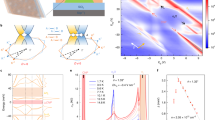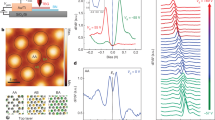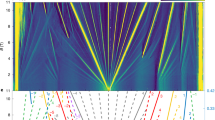Abstract
Charge carriers in bilayer graphene are widely believed to be massive Dirac fermions1,2,3 that have a bandgap tunable by a transverse electric field3,4. However, a full transport gap, despite its importance for device applications, has not been clearly observed in gated bilayer graphene5,6,7, a long-standing puzzle. Moreover, the low-energy electronic structure of bilayer graphene is widely held to be unstable towards symmetry breaking either by structural distortions, such as twist8,9,10, strain11,12, or electronic interactions7,13,14 that can lead to various ground states. Which effect dominates the physics at low energies is hotly debated. Here we show both by direct band-structure measurements and by calculations that a native imperfection of bilayer graphene, a distribution of twists whose size is as small as ~0.1°, is sufficient to generate a completely new electronic spectrum consisting of massive and massless Dirac fermions. The massless spectrum is robust against strong electric fields, and has a unusual topology in momentum space consisting of closed arcs having an exotic chiral pseudospin texture, which can be tuned by varying the charge density. The discovery of this unusual Dirac spectrum not only complements the framework of massive Dirac fermions, widely relevant to charge transport in bilayer graphene, but also supports the possibility of valley Hall transport15.
This is a preview of subscription content, access via your institution
Access options
Subscribe to this journal
Receive 12 print issues and online access
$259.00 per year
only $21.58 per issue
Buy this article
- Purchase on Springer Link
- Instant access to full article PDF
Prices may be subject to local taxes which are calculated during checkout




Similar content being viewed by others
References
Geim, A. K. & Novoselov, K. S. The rise of graphene. Nature Mater. 6, 183–191 (2007).
Novoselov, K. S. et al. Unconventional quantum Hall effect and Berry’s phase of 2π in bilayer graphene. Nature Phys. 2, 177–180 (2006).
McCann, E. & Fal’ko, V. I. Landau-level degeneracy and quantum Hall effect in a graphite bilayer. Phys. Rev. B 96, 086805 (2006).
Ohta, T., Bostwick, A., Seyller, T., Horn, K. & Rotenberg, E. Controlling the electronic structure of bilayer graphene. Science 313, 951–954 (2006).
Oostinga, J. B., Heersche, H., B., Liu, X., Morpurgo, A. F. & Vandersypen, L. M. K. Gate induced insulating state in bilayer graphene devices. Nature Mater. 7, 151–156 (2008).
Li, J., Martin, I., Büttiker, M. & Morpurgo, A. F. Topological origin of subgap conductance in insulating bilayer graphene. Nature Phys. 7, 38–42 (2010).
Weitz, R. T., Allen, M. T., Feldman, B. E., Martin, J. & Yacoby, A. Broken-symmetry states in doubly gated suspended bilayer graphene. Science 330, 812–816 (2010).
Lopes dos Santos, J. M. B., Peres, N. M. R. & Castro Neto, A. H. Graphene bilayer with a twist: Electronic structure. Phys. Rev. Lett. 99, 256802 (2007).
Bistritzer, R. & MacDonald, A. H. Moiré bands in twisted double-layer graphene. Proc. Natl Acad. Sci. USA 108, 12233–12237 (2011).
Mele, E. J. Band symmetries and singularities in twisted multilayer graphene. Phys. Rev. B 84, 235439 (2011).
Mucha-Kruczyński, M., Aleiner, I. L. & Fal’ko, V. I. Strained bilayer graphene: Band structure topology and Landau level spectrum. Phys. Rev. B 84, 041404 (2011).
Son, Y-W., Choi, S-M., Hong, Y. P., Woo, S. & Jhi, S-H. Electronic topological transition in sliding bilayer graphene. Phys. Rev. B 84, 155410 (2011).
Mayorov, A. S. et al. Interaction-driven spectrum reconstruction in bilayer graphene. Science 333, 860–863 (2011).
Velasco, J. Jr et al. Transport spectroscopy of symmetry-broken insulating states in bilayer graphene. Nature Nanotech. 7, 156–160 (2012).
Xiao, D., Yao, W. & Niu, Q. Valley-contrasting physics in graphene: Magnetic moment and topological transport. Phys. Rev. Lett. 99, 236809 (2007).
Ho, J. H., Lu, C. L., Hwang, C. C., Chang, C. P. & Lin, M. F. Coulomb excitations in AA- and AB-stacked bilayer graphites. Phys. Rev. B 74, 085406 (2006).
Nanda, B. R. K. & Satpathy, S. Strain and electronic field modulation of the electronic structure of bilayer graphene. Phys. Rev. B 80, 165430 (2009).
Riedl, C., Coletti, C., Iwasaki, T., Zakharov, A. A. & Starke, U. Quasi-free-standing epitaxial graphene on SiC obtained by hydrogen intercalation. Phys. Rev. Lett. 103, 246804 (2009).
Bostwick, A. et al. Observation of plasmarons in quasi-freestanding doped graphene. Science 328, 999–1002 (2010).
Speck, F. et al. The quasi-free-standing nature of graphene on H-saturated SiC(0001). Appl. Rev. Lett. 99, 122106 (2011).
Ohta, T. et al. Interlayer interaction and electronic screening in multilayer graphene investigated with angle-resolved photoemission spectroscopy. Phys. Rev. Lett. 98, 206802 (2007).
Mucha-Kruczyński, M. et al. Characterization of graphene through anisotropy of constant-energy maps in angle-resolved photoemission. Phys. Rev. B 77, 195403 (2008).
Gierz, I., Henk, J., Höchst, H., Ast, C. R. & Kern, K. Illuminating the dark corridor in graphene: Polarization dependence of angle-resolved photoemission spectroscopy on graphene. Phys. Rev. B 83, 121408 (2011).
Lauffer, P. et al. Atomic and electronic structure of few-layer graphene on SiC(0001) studied with scanning tunneling microscopy and spectroscopy. Phys. Rev. B 77, 155426 (2008).
Liu, Z., Suenaga, K., Harris, P. J. F. & Iijima, S. Open and closed edges of graphene layers. Phys. Rev. Lett. 102, 015501 (2009).
Borysiuk, J., Soltys, J. & Piechota, J. Stacking sequence dependence of graphene layers on SiC(0001)–Experimental and theoretical investigation. J. Appl. Phys. 109, 093523 (2011).
Walter, A. L. et al. Small scale rotational disorder observed in epitaxial graphene on SiC(0001). New J. Phys. 15, 023019 (2013).
Meyer, J. C., Geim, A. K., Katsnelson, M. I., Novoselov, K. S., Booth, T. J. & Roth, S. The structure of suspended graphene sheets. Nature 446, 60–63 (2007).
Watcharinyanon, S. et al. Hydrogen intercalation of graphene grown on 6H-SiC(0001). Surf. Sci. 605, 1662–1668 (2011).
Berger, C. et al. Electronic confinement and coherence in patterned epitaxial graphene. Science 312, 1191–1196 (2006).
Acknowledgements
This work and ALS were supported by the US Department of Energy, Office of Sciences under Contract No. DE-AC02-05CH11231. K.S.K. acknowledges support by an NRF Grant funded by the Korean Government (NRF-2011-357-C00022). A.L.W. acknowledges support by the Max Planck Society. L.M. acknowledges support by Grant PA00P2-136420 from the Swiss National Science Foundation (SNSF). T.S. was supported by the DFG in the framework of the Priority Program 1459 ‘Graphene’. We thank F. Speck, M. Ostler and F. Fromm for assistance during sample preparation, and J. Denlinger for assistance during measurement.
Author information
Authors and Affiliations
Contributions
E.R., K.H. and A.B. conceived the experiments. K.S.K. performed the experiments, data analysis and interpretations with help from L.M. and supervision by A.B. and E.R. A.L.W. and T.S. fabricated the samples, and performed the preliminary experiments. K.S.K., E.R., A.B. and K.H. wrote the manuscript with input from all other co-authors. E.R. rendered the three-dimensional bands and movie.
Corresponding author
Ethics declarations
Competing interests
The authors declare no competing financial interests.
Supplementary information
Rights and permissions
About this article
Cite this article
Kim, K., Walter, A., Moreschini, L. et al. Coexisting massive and massless Dirac fermions in symmetry-broken bilayer graphene. Nature Mater 12, 887–892 (2013). https://doi.org/10.1038/nmat3717
Received:
Accepted:
Published:
Issue Date:
DOI: https://doi.org/10.1038/nmat3717
This article is cited by
-
Visualization of the flat electronic band in twisted bilayer graphene near the magic angle twist
Nature Physics (2021)
-
Reducible Fermi Surface for Multi-layer Quantum Graphs Including Stacked Graphene
Communications in Mathematical Physics (2021)
-
Asymmetry-enriched electronic and optical properties of bilayer graphene
Scientific Reports (2019)
-
AB-stacked bilayer graphene zigzag nanoribbons: sensors for interlayer single molecule detection
Journal of Nanoparticle Research (2019)
-
Massive Dirac fermions in a ferromagnetic kagome metal
Nature (2018)



